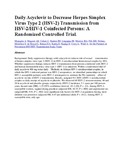Daily Acyclovir to Decrease Herpes Simplex Virus Type 2 (HSV-2) Transmission from HSV-2/HIV-1 Coinfected Persons: A Randomized Controlled Trial.

View/
Date
2013Author
Mujugira, A
Magaret, AS
Celum, C
Baeten, JM
Lingappa, JR
Morrow, RA
Fife, KH
Delany-Moretlwe, S
de Bruyn, G
Bukusi, EA
Karita, E
Kapiga, S
Corey, L
Wald, A
Type
ArticleLanguage
enMetadata
Show full item recordAbstract
Background. Daily suppressive therapy with valacyclovir reduces risk of sexual transmission of herpes simplex virus type 2 (HSV-2) in HSV-2-serodiscordant heterosexual couples by 48%. Whether suppressive therapy reduces HSV-2 transmission from persons coinfected with HSV-2 and human immunodeficiency virus type 1 (HIV-1) is unknown. Methods. Within a randomized trial of daily acyclovir 400 mg twice daily in African HIV-1 serodiscordant couples, in which the HIV-1-infected partner was HSV-2 seropositive, we identified partnerships in which HIV-1-susceptible partners were HSV-2 seronegative to estimate the effect of acyclovir on risk of HSV-2 transmission. Results. We randomly assigned 911 HSV-2/HIV-1-serodiscordant couples to daily receipt of acyclovir or placebo. We observed 68 HSV-2 seroconversions, 40 and 28 in acyclovir and placebo groups, respectively (HSV-2 incidence, 5.1 cases per 100 person-years; hazard ratio [HR], 1.35 [95% confidence interval, .83-2.20]; P = .22). Among HSV-2-susceptible women, vaginal drying practices (adjusted HR, 44.35; P = .004) and unprotected sex (adjusted HR, 9.91; P = .002) were significant risk factors for HSV-2 acquisition; having more children was protective (adjusted HR, 0.47 per additional child; P = .012). Among HSV-2-susceptible men, only age ≤30 years was associated with increased risk of HSV-2 acquisition (P = .016). Conclusions. Treatment of African HSV-2/HIV-1-infected persons with daily suppressive acyclovir did not decrease risk of HSV-2 transmission to susceptible partners. More-effective prevention strategies to reduce HSV-2 transmission from HIV-1-infected persons are needed.
URI
http://www.ncbi.nlm.nih.gov/pubmed/23901094http://erepository.uonbi.ac.ke:8080/xmlui/handle/123456789/57409
Citation
J Infect Dis. 2013 Nov;208(9):1366-1374. Epub 2013 Jul 30.Publisher
University of Nairobi School of Medicine
Collections
- Faculty of Health Sciences (FHS) [10378]
